What Is the Biggest Contribution Frida Kahlo Gave to Art
FRIDA declared that her art was not surrealistic nor did it reflect dreams, in spite of what they might seem. Her paintings were representations of her own life and emotions: "Me pinto a mí misma porque soy a quien mejor conozco."
La Columna Rota
The Broken Column
For Frida, life was a series of troubles and challenges. When she was eighteen she was in a disastrous bus blow. The pain from her injuries would brand her endure for the residuum of her life.
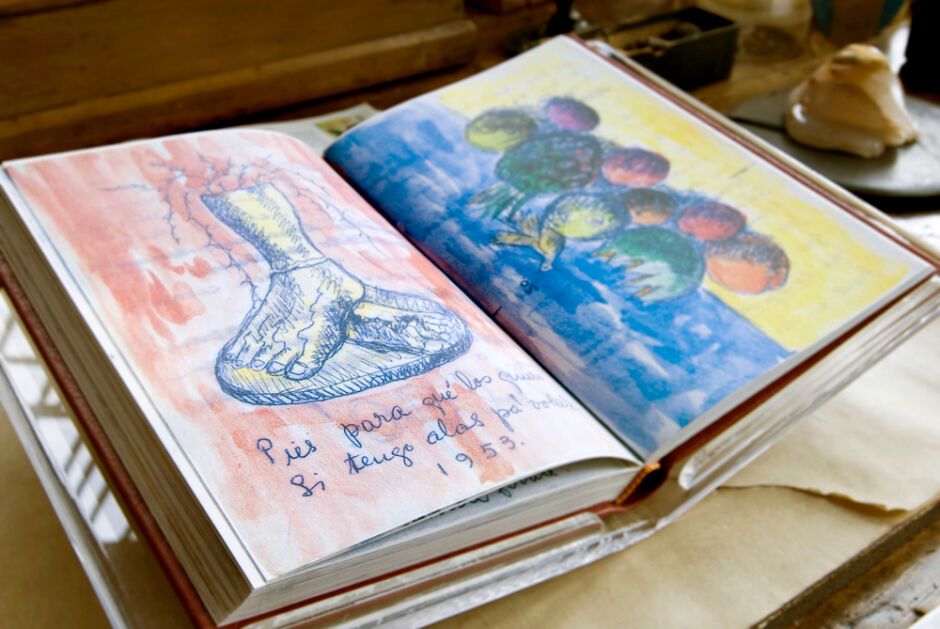
Cartoon "Pies para qué los quiero si tengo alas para volar" (Anxiety. Why do I want them for? If I accept wings to wing)
In the painting (which you tin come across in the video below), Frida drew herself naked from the waist upward, wearing a steel brace to hold her body every bit the doctors told her to practise. A huge opening runs through her torso to reveal her broken spine. Hundreds of nails are embedded in her body, the one in her heart showing an enormous sadness. Nosotros can see tears in her eyes and, behind her, a desolate background. The entire work is a drastic cry of hurting.
Frida y Diego Rivera
Frida and Diego Rivera
Kahlo worked on this portrait during the commencement years of their marriage. She painted both of them face up forwards with serious expressions, merely belongings easily as a symbol of the slap-up love they experience for each other. Y'all can see Frida and Diego Rivera portrait at SFMOMA.

Frida stuck to reality, showing how different the sizes of their bodies were. Diego was tall and burly; she was small-scale and sparse. Since the showtime of her relationship with Diego, Frida changed the way she dressed and adopted typical Mexican clothes. She painted her husband holding a palette and brush in his right hand. Frida admired his creative talent. Unlike other pieces, where lush backgrounds and colorful scenes dominate, in this moving-picture show in that location is nothing to distract the attention from the two characters.
Autorretrato con el pelo suelto + Autorretrato con pelo corto (or, hairstyles in Frida Kahlo paintings)
Self-portrait with loose hair and Self-Portrait with Cropped Pilus
"Aquí me pinté yo, Frida Kahlo, con mi reflejo en el espejo. Tengo 37 años y es Julio de 1947. En Coyoacán, México, el sitio en donde nací" reads a band at the bottom of loose hair the painting. Information technology is definitely a piece of work in which she seeks to reinforce her identity, as indicated by the whorl'due south presence in the foreground with its mention of the city where she was born.
In Frida Kahlo paintings, the hair is a primary character in several pieces of fine art. In some, by drawing it beautifully long and thick, she seeks her husband's admiration — Diego admitted Frida's pilus was one of the things he loved most nigh her. Simply Frida has also represented herself with cropped hair and masculine outfits, such as in the 1940 portrait that MoMA holds in its drove.

Autorretrato en la frontera entre México y EEUU
Self-portrait at the edge between Mexico and the The states
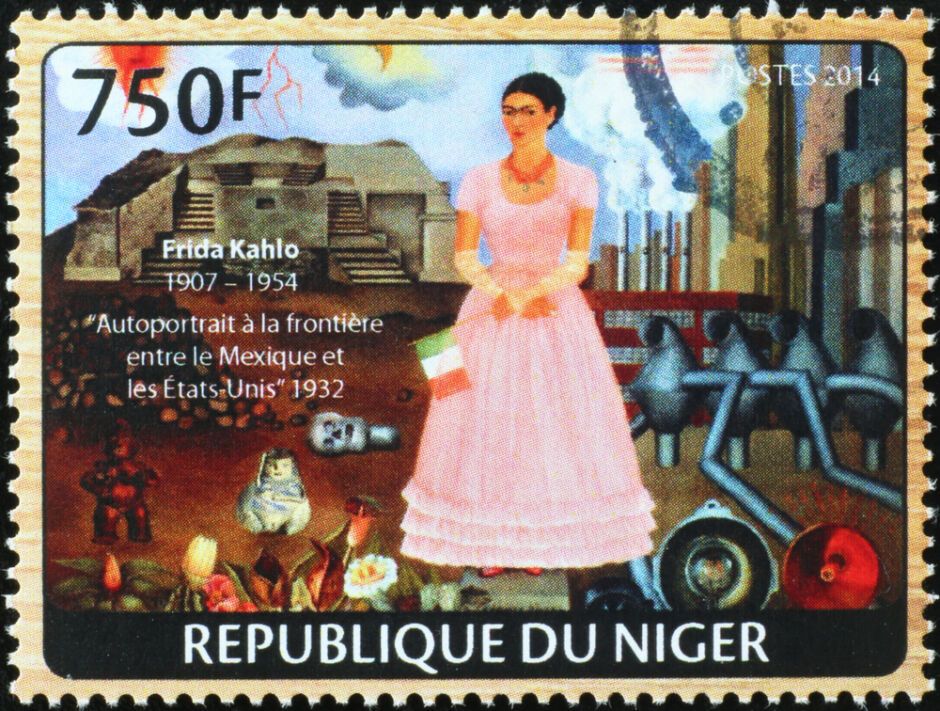
When Diego was invited to work in the US, both he and Frida stayed there for almost iii years. Diego loved his new life in a place where his talent was appreciated. Only for his wife, the new land lost its charm speedily.
Frida missed Mexico and wanted to go back. Out of those feelings emerged this painting. Frida is in the center of the picture, on a pedestal, wearing a uncomplicated pinkish dress. The background is total of images that evoke both countries. On one side, her vision of Mexico is represented by nature, vibrant color and images of the Aztec culture. On the other side, in the USA prevail industry and technology. Kahlo holds in her mitt a trivial Mexican flag, signifying the place where her heart belongs.
Henry Ford Hospital
The natural abortion she suffered in 1932, while living in America, was i of the most traumatic moments of Frida's life. In the painting, nosotros see her lying in a hospital bed, covered in blood. From her withal swollen stomach emerge vi red and thin filaments that appear to be umbilical cords. Each i of these filaments connect her torso to an abortion-related epitome: the fetus of a baby male child, "Dieguito," the son she longed to take simply never did; a majestic flower that she received as a gift from her hubby; a snail that symbolizes a slow and painful abortion; the figurine of a woman's open up torso showing her organs (almost declaring she discrete from her body as it had not been able to carry out the pregnancy).
She painted a machine to reflect all the cold instruments used for uterine curettage; and finally, through the epitome of her pelvis she transmits the physical pain.
The painting is part of the Museo Dolores Olmedo collection, and you can run into information technology online here.

Autorretrato con collar de espinas
Cocky-portrait with thorn necklace
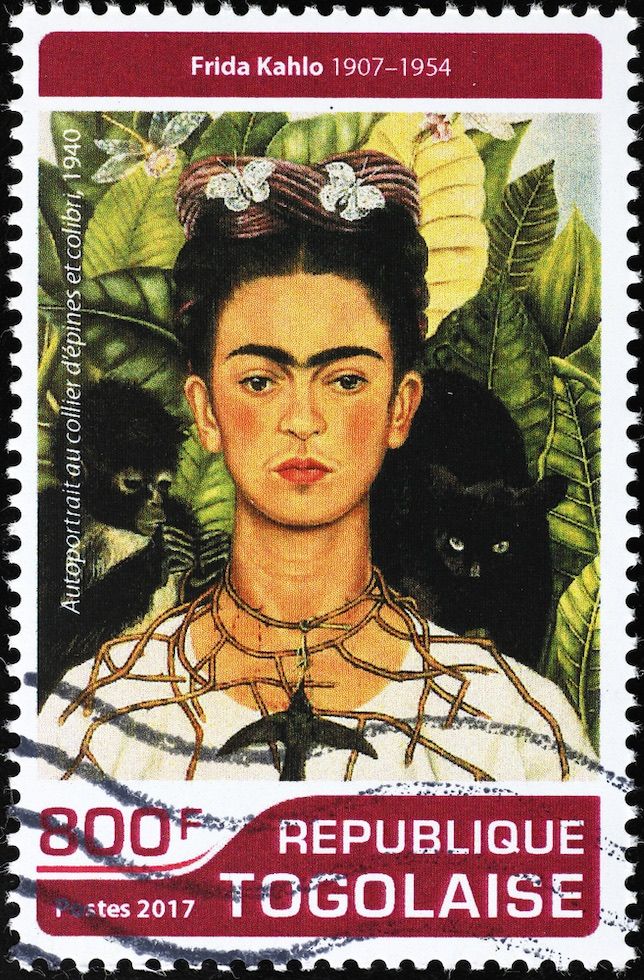
Frida painted this portrait during a fourth dimension of crisis in her marriage. The principal element is the thorns necklace sinking into her cervix — a sign of pain caused by her broken relationship with Diego. This symbol comes from the famous Crown of Thorns which is very meaning for Christians.
From the necklace hangs a black, dead hummingbird, its outstretched wings compared to the shape of Frida's eyebrows. The hummingbird symbolizes the end of her spousal relationship. On her shoulders is a black true cat (a common symbol of misfortune) and her monkey (a souvenir from Diego), that looks distant and indifferent, just equally she felt treated past her husband. In this painting, Frida is wearing the traditional Mexican wearing apparel which had already become part of her ain identity.
Las Dos Fridas
The 2 Fridas
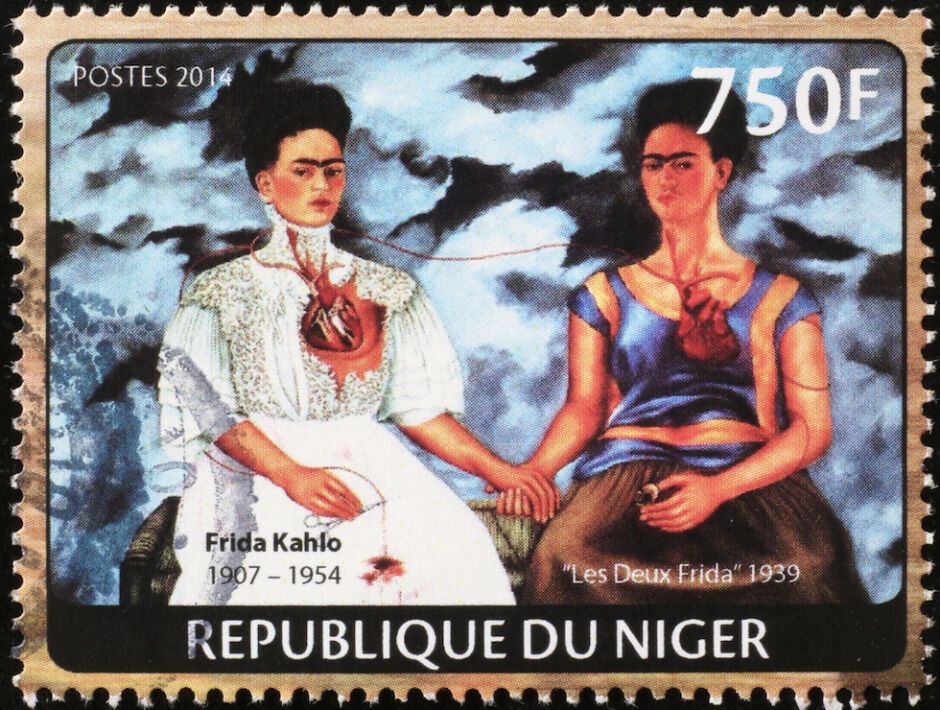
The inevitable happened. In 1939 Frida and Diego divorced. She was devastated and her emotions were reflected in this painting. She drew two identical Fridas, simply with different personalities. One is the "Mexican Frida;" the i Diego Rivera cruel in dearest with. The other is "European Frida" — the new and independent artist that'southward recognized worldwide, but likewise, the woman her husband abased.
Their hearts are exposed over their clothing, and at that place is a thin vein passing through them both, uniting them. Victorian Frida holds surgical pair of scissors that cut the vein in her lap, and the blood spills on her white dress. Frida was experiencing existent sorrow, the kind of sorrow that made her feel she could bleed from the pain. Both women are holding hands equally if the artist accustomed she was the only person who understood her, loved her, and could help her to move on.
Autorretrato como tehuana
Self-Portrait as a Tehuana
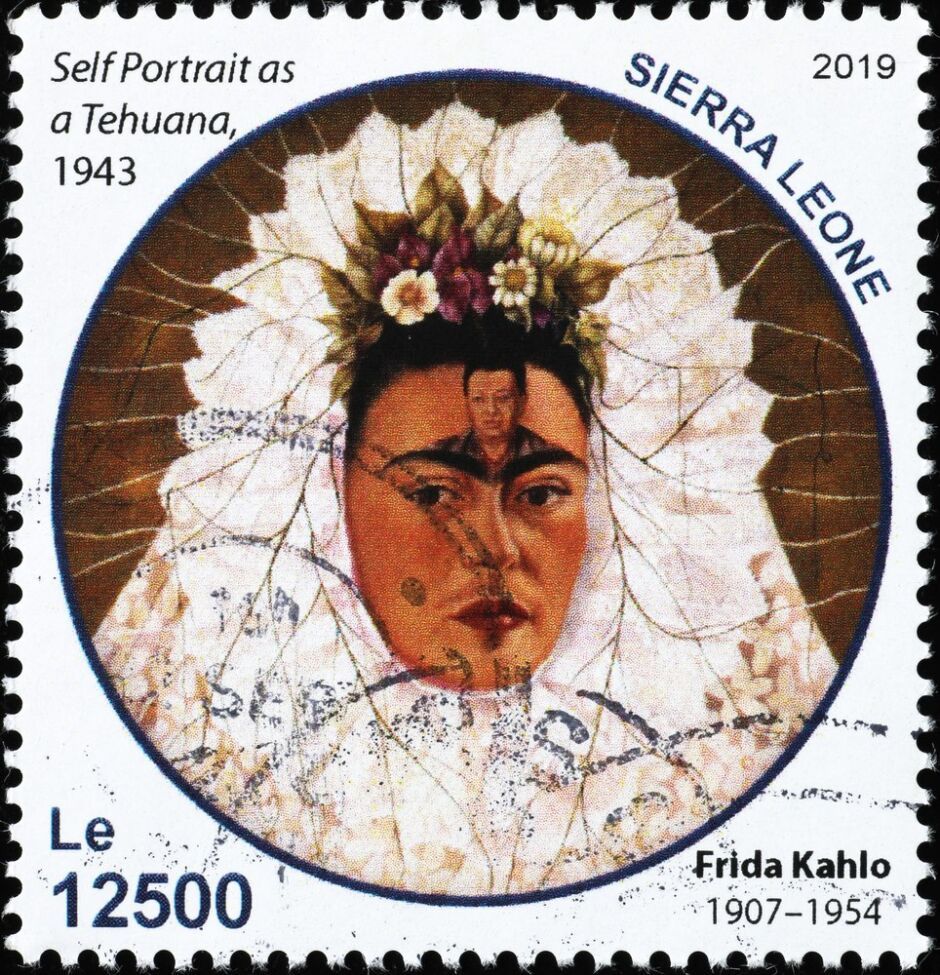
Despite their divorce, Frida never stopped loving Diego. She knew her ex-hubby wouldn't surrender having affairs with other women and would never be able to exist the hubby she desired. However, she had still place for him in her middle and her paintings.
In this cocky-portrait, she painted his face on her forehead, in identify of the 3rd centre, ever nowadays. Frida wears an elaborate tehuana Mexican clothes — Diego's favorite — maybe in an attempt to recover his admiration. Around her face the whole painting is total of cracks, symbolizing the marks in her soul.
El venado herido
The Wounded Deer

There's a way to know when a painting by Kahlo expresses a feeling of unbearable pain — in those cases, Frida was unable to replicate the suffering in her own body and therefore she used other images. In this case, she drew a deer with her face on it.
The poor creature's body is fully pierced by arrows. It is alone and injured in the heart of the woods. Frida painted this pic later on a spinal surgery that would supposedly lessen her pain, simply on the reverse, it brought even more backaches. In the lower left corner of the work, Frida scrawled the word "karma," significant "fate."
El abrazo de amor del Universo
The loving embrace of the Universe

Frida Kahlo paintings appear in multiple everyday objects, such equally banknotes and stamps. In "The loving embrace of the Universe", included in the note abobe, elements grow: Mexican representations of the mean solar day and night, the moon and the dominicus, life and decease, Mother Nature. In the center of the picture we see Frida hugging a naked and childish Diego, illustrating the great love she had for her hubby — a honey that was changing shape. At the same time, the image reminds united states of Frida'due south inability to procreate, which undoubtedly was the greatest wound in her life.
Read a version of this article nigh Frida Kahlo paintings in Spanish here.
fitzgeraldcoundel.blogspot.com
Source: https://matadornetwork.com/life/story-behind-10-frida-kahlo-paintings/
0 Response to "What Is the Biggest Contribution Frida Kahlo Gave to Art"
Post a Comment